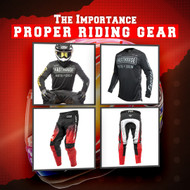Safety First: The Importance of Proper Riding Gear
Posted by undefined
Riding a motorcycle is an exhilarating experience, offering freedom and adventure on the open road. However, with this freedom comes the responsibility of ensuring safety on every ride. One of the most critical aspects of motorcycle safety is wearing the right gear. From helmets to riding jackets, each piece plays a vital role in protecting riders from potential hazards and minimizing the risks associated with motorcycle accidents.
In this blog, we delve into the importance of proper riding gear, focusing on key elements such as motorcycle helmets and riding jackets. Understanding why these gear items are essential can make a significant difference in ensuring a safe and enjoyable riding experience.
The Vital Role of Motorcycle Helmets
When it comes to motorcycle safety, helmets stand out as the most crucial piece of gear. A motorcycle helmet is not just an accessory but a lifesaving tool that significantly reduces the risk of head injuries in the event of an accident. According to the National Highway Traffic Safety Administration (NHTSA), wearing a helmet reduces the risk of motorcyclist fatality by 37% and head injury by 69%.
Helmets work by absorbing the impact energy during a crash, thereby protecting the rider's head and brain. This level of protection can be the difference between life and death or between a minor injury and a life-altering one. Numerous studies and data support the effectiveness of helmets, making them a non-negotiable aspect of motorcycle safety.
Furthermore, wearing a helmet is not just about personal safety but also a legal requirement in many jurisdictions. Various safety standards and certifications ensure that helmets meet specific quality and safety criteria, providing riders with added assurance of their protective capabilities.
The Significance of Motorcycle Riding Jackets
In addition to helmets, motorcycle riding jackets play a crucial role in protecting riders from injuries. These jackets are designed with durable materials such as leather or textile with built-in armor in key impact zones like the shoulders, elbows, and back. This armor provides additional protection by absorbing and dispersing impact energy, reducing the risk of fractures and abrasions during a crash.
Moreover, motorcycle jackets are designed to offer weather protection, keeping riders comfortable in various conditions. They often feature ventilation systems to prevent overheating during hot weather and removable liners for insulation in cold weather. This versatility ensures that riders can enjoy their rides safely and comfortably regardless of the climate.
Choosing the Right Riding Gear
When it comes to choosing the right riding gear, several factors come into play. Firstly, consider the fit of the gear, especially helmets and jackets. A properly fitting helmet should sit snugly on the head without being too tight or loose, and it should not obstruct vision or movement. Similarly, riding jackets should fit well without being restrictive, allowing for freedom of movement while riding.
Secondly, prioritize safety certifications and standards when selecting gear. Look for helmets that meet DOT (Department of Transportation) standards or other recognized certifications such as Snell or ECE (Economic Commission for Europe). These certifications ensure that the gear has undergone rigorous testing and meets specific safety requirements.
Consider the type of riding you'll be doing and choose gear that suits your riding style. For example, if you often ride in hot climates, opt for a well-ventilated helmet and a lightweight, breathable jacket. On the other hand, if you ride in cold or wet conditions, choose gear with thermal insulation and waterproofing features.
Lastly, don't overlook the importance of visibility and reflective elements in your gear, especially if you ride during low-light conditions or at night. Helmets and jackets with reflective strips or high-visibility colors can significantly enhance your visibility to other motorists, reducing the risk of accidents.
Maintaining and Inspecting Your Riding Gear
Regular maintenance and inspection of your motorcycle riding gear are essential to ensure its effectiveness and longevity. Start by inspecting your helmet for any signs of damage, such as cracks, dents, or loose padding. Replace your helmet if it has been involved in a crash or shows signs of wear and tear that could compromise its safety.
Similarly, check your riding jacket for abrasions, tears, or worn-out armor. Make sure all zippers, straps, and closures are in good working condition to provide proper protection. Cleaning and conditioning leather jackets can also help maintain their durability and weather resistance.
Inspect any other riding gear such as gloves, pants, and boots for damage or wear. Replace items that no longer provide adequate protection or functionality.
Staying Visible and Alert
Visibility is crucial for motorcycle riders, especially in traffic or low-light conditions. Invest in high-visibility gear, such as jackets with reflective strips or helmets with bright colors, to make yourself more visible to other motorists. Use additional accessories like reflective tape on your bike and gear to enhance visibility from all angles. Always ride with your headlights on, even during the day, to increase your visibility to other road users. Stay alert and focused while riding, constantly scanning your surroundings for potential hazards. Avoid distractions such as using electronic devices or wearing headphones that can impair your ability to react to changing traffic conditions. Consider taking advanced riding courses to improve your skills and safety awareness on the road. These courses teach defensive riding techniques, hazard recognition, and emergency maneuvers, making you a more confident and competent rider.
Conclusion
In conclusion, prioritizing safety through proper riding gear is not just a choice but a responsibility for every motorcycle rider. Your gear is your first line of defense against potential accidents and injuries on the road. By investing in high-quality helmets, jackets, gloves, pants, and boots, you not only protect yourself but also set a positive example for other riders. Remember, safety starts before you even hit the road. Ensure your gear is well-maintained, fits properly, and meets safety standards. Stay visible, stay alert, and stay educated about the latest safety practices and technologies in motorcycle gear.

